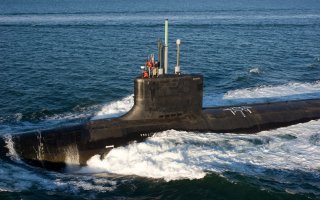Virginia: The Missile Packed Submarine Built to Fight China in a War
Last week, the United States Navy awarded a $2.42 billion contract modification to General Dynamics' Electric Boat subsidiary to build an additional Block V Virginia-class submarine equipped with the Virginia Payload Module (VPM). The deal was awarded by The Naval Sea Systems Command in Washington D.C.
Last week, the United States Navy awarded a $2.42 billion contract modification to General Dynamics' Electric Boat subsidiary to build an additional Block V Virginia-class submarine equipped with the Virginia Payload Module (VPM). The deal was awarded by The Naval Sea Systems Command in Washington D.C.
The original contract that was awarded in December 2019 was for nine boats with an option for a tenth. With this added submarine, the total cost of the contract with prime contractor Electric Boat will be $24.1 billion, a net increase of $1.89 billion for the full contract.
Nasdaq reported that General Dynamics has substantially reduced the cost as well as the delivery time of the Virginia-class boats from eighty-four to just sixty-six months, while also improving mission capability and ship construction quality. The defense contractor is also one of only two companies in the world that is equipped to build nuclear-powered submarines, and as such General Dynamics has enjoyed a dominant position as a navy contractor.
"The 17,000 shipbuilders of Electric Boat are pleased to receive the award for the tenth Block V ship and are ready to meet the generational challenge of building the Virginia and Columbia classes concurrently," Kevin Graney, president of General Dynamics' Electric Boat said in a statement that was also posted to Facebook. "We are grateful for the continued support of our federal delegation, who strongly advocated for this important funding."
According to the Department of Defense (DoD), Electric Boat will continue to work with Huntington Ingalls Industries' Newport News Shipbuilding division on the construction of the submarine. Contract work will occur in Virginia, Rhode Island, California, Connecticut, Maryland, Arizona, Pennsylvania and other areas within and outside the U.S. through February 2030 according to Govconwire.com.
The United States Navy has been focused on strengthening its naval power by upgrading its fleet of missile submarines in response to potential threats from near-peer adversaries including China.
The Virginia-class nuclear-powered cruise missile attack submarines were introduced in the mid-2000s as a replacement to the Cold War-era Los Angeles-class submarine line, thirty of which have already been retired. Three of the Virginia blocks were focused heavily on cost-efficiency improvements: Block II slashed roughly $300 million worth of program costs, introducing a more efficient production process; the eight Block III subs incorporated a new bow design including a new sonar array and large diameter vertical payload tubes, and Block IV brought reduced maintenance periods and lowered total ownership costs to boost the program's sustainability well into the coming decades.
The Block V submarines feature the VPM, an 84-foot section of the boat that will serve as an undersea vertical launcher for missiles. Each VPM on the Block Vs provides the capacity for 40 cruise missiles. Additionally, with advancements in hypersonic missile technology, the Virginia-class's larger launcher will be well suited to host such weapons once they are deployable. The boats can also host the new version of the anti-ship Maritime Strike Tomahawk, a part of the Block V upgrade that will begin being delivered to the service later this month.
Peter Suciu is a Michigan-based writer who has contributed to more than four dozen magazines, newspapers and websites. He regularly writes about military small arms, and is the author of several books on military headgear including A Gallery of Military Headdress, which is available on Amazon.com.

